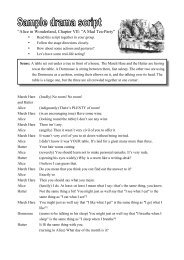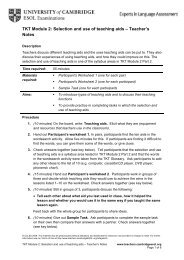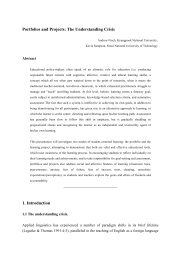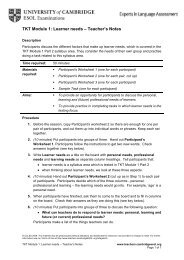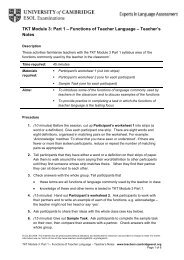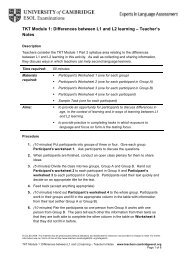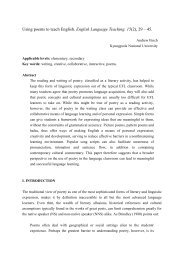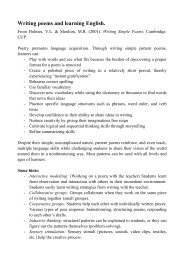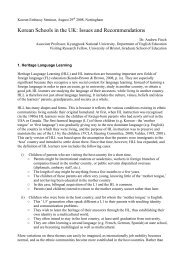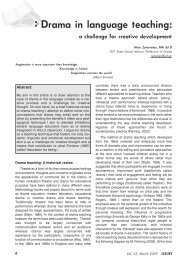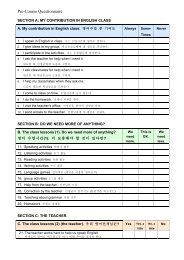Peace Begins in the Classroom - Finchpark
Peace Begins in the Classroom - Finchpark
Peace Begins in the Classroom - Finchpark
Create successful ePaper yourself
Turn your PDF publications into a flip-book with our unique Google optimized e-Paper software.
PAGE 1<br />
Promot<strong>in</strong>g <strong>Peace</strong> <strong>in</strong> <strong>the</strong> EFL <strong>Classroom</strong><br />
Andrew F<strong>in</strong>ch<br />
Kyungpook National University<br />
Korea TESOL Journal 7(1)<br />
Abstract<br />
Humanistic pr<strong>in</strong>ciples of education, which received grow<strong>in</strong>g attention <strong>in</strong> <strong>the</strong> 20th<br />
century, can be traced back to Aristotle and Confucius. However, <strong>the</strong>y are <strong>in</strong>creas<strong>in</strong>gly<br />
relevant to a modern society <strong>in</strong> which competitive, <strong>in</strong>dividualized and <strong>in</strong>tellectualized<br />
education serves only to enhance <strong>the</strong> destructive tendency of a technology-based<br />
corporate-owned world. This paper argues that <strong>the</strong> promotion of humanistic values, at all<br />
levels of education, should be a prime goal of educators, <strong>in</strong> order to develop <strong>in</strong> students<br />
<strong>in</strong>terpersonal and <strong>in</strong>trapersonal skills, which, <strong>in</strong> addition to problem solv<strong>in</strong>g, critical<br />
th<strong>in</strong>k<strong>in</strong>g and responsibility, are essential if <strong>the</strong>y are to make a positive and peaceful<br />
contribution to <strong>the</strong> “race between education and catastrophe” (H.G. Wells, 1920). It is <strong>the</strong><br />
responsibility of teachers to model and promote a peaceful society <strong>in</strong> <strong>the</strong>ir classrooms, so<br />
that root causes of corruption, <strong>in</strong>stitutional aggression, poverty and sickness may be<br />
exam<strong>in</strong>ed, and learn<strong>in</strong>g experiences <strong>in</strong>ternalized <strong>in</strong> <strong>the</strong> “safe” community that is a<br />
microcosm of world society.<br />
Language classrooms are, however, known for promot<strong>in</strong>g anxiety, stress and<br />
competition, ra<strong>the</strong>r than <strong>the</strong> collaboration and sensitive awareness. This paper <strong>the</strong>refore<br />
suggests how teachers might identify and address sources of negative affect <strong>in</strong> <strong>the</strong>ir<br />
classrooms, and how <strong>the</strong>y might promote humanistic values through appropriate learn<strong>in</strong>g<br />
materials, and a non-threaten<strong>in</strong>g learn<strong>in</strong>g environment.<br />
1. Introduction<br />
Before <strong>in</strong>vestigat<strong>in</strong>g <strong>the</strong> rationale for peace <strong>in</strong> <strong>the</strong> classroom it is necessary to ask what is<br />
meant by peace Why is it desirable What does it have to do with language learn<strong>in</strong>g Here<br />
are some def<strong>in</strong>itions from two English Language Teach<strong>in</strong>g (ELT) dictionaries:<br />
i) If you have peace, you are not be<strong>in</strong>g disturbed, and you are <strong>in</strong> calm, quiet<br />
surround<strong>in</strong>gs. ii) If you have a feel<strong>in</strong>g of peace, you feel contented and calm and
PAGE 2<br />
not at all worried. iii) If <strong>the</strong>re is peace among a group of people, <strong>the</strong>y live or work<br />
toge<strong>the</strong>r <strong>in</strong> a friendly way and do not quarrel. (Coll<strong>in</strong>s Cobuild English dictionary<br />
for advanced learners, 2001)<br />
i) A condition or period <strong>in</strong> which <strong>the</strong>re is no war between two or more nations. ii)<br />
The state of freedom from disorder with<strong>in</strong> a country, with <strong>the</strong> citizens liv<strong>in</strong>g<br />
accord<strong>in</strong>g to <strong>the</strong> law. iii) A freedom from anxiety or troubl<strong>in</strong>g thoughts. iv) In a<br />
state of quiet or calm. (Longman dictionary of English language and culture,<br />
1992)<br />
<strong>Classroom</strong> peace thus implies cooperative work without disorder, <strong>the</strong> participants be<strong>in</strong>g<br />
unworried, free from anxiety, calm, and not quarrel<strong>in</strong>g. This is obviously a description of a<br />
desirable learn<strong>in</strong>g environment, but is it an end <strong>in</strong> itself, or is <strong>the</strong>re a deeper aspect to <strong>the</strong><br />
issue This paper proposes that peace is a desirable state for society as a whole, that this state<br />
has not been (and will not be) achieved by means of competitive and exclusive educational<br />
policies and methods, and that humanistic educational goals, approached <strong>in</strong> a holistic sett<strong>in</strong>g,<br />
offer a path to <strong>the</strong> realisation of such a state. This issue is not simply one of mak<strong>in</strong>g life<br />
comfortable for <strong>the</strong> greatest number of people, for <strong>the</strong> current destructive potential of<br />
weapons technology and <strong>the</strong> corporate plunder<strong>in</strong>g of <strong>the</strong> world’s resources have made it<br />
<strong>in</strong>creas<strong>in</strong>gly a matter of preserv<strong>in</strong>g <strong>the</strong> human race:<br />
Human history becomes more and more a race between education and catastrophe.<br />
(H. G. Wells, 1920)<br />
Now <strong>the</strong> whole question of <strong>the</strong> educator’s role <strong>in</strong> deal<strong>in</strong>g with planetary crisis<br />
becomes prom<strong>in</strong>ent. (O’Sullivan, 2001, p. 46)<br />
Some type of holistic, or participat<strong>in</strong>g consciousness and a correspond<strong>in</strong>g<br />
sociopolitical formation have to emerge if we are to survive as a species. (Berman,<br />
1981, p. 23)<br />
Establish<strong>in</strong>g last<strong>in</strong>g peace is <strong>the</strong> work of education; all politics can do is keep us<br />
out of war. (Montessori, cited <strong>in</strong> McCarthy [Ed.], 2001, p. 35)<br />
2. The Present Situation<br />
The society <strong>in</strong> which we live is based upon aggression: <strong>the</strong> “market economy” espouses <strong>the</strong><br />
survival of <strong>the</strong> fittest; <strong>in</strong>ternational politics bows to <strong>the</strong> superiority of <strong>the</strong> aggressor; and<br />
competition is a fact of life <strong>in</strong> which <strong>the</strong> w<strong>in</strong>ner takes all. Violence is <strong>the</strong> language of<br />
governments as <strong>the</strong>y oppress weaker states, squeez<strong>in</strong>g <strong>the</strong>m of <strong>the</strong>ir natural resources <strong>in</strong> return
PAGE 3<br />
for dubious aid and huge debts; genocide, domestic violence (human rights abuses), pollution,<br />
and corruption, are rout<strong>in</strong>ely overlooked as countries rush to share <strong>the</strong> spoils of global trade;<br />
developed countries supply arms to <strong>the</strong> rest of <strong>the</strong> world (<strong>the</strong> United States supplies 75% of<br />
<strong>the</strong> weapons used <strong>in</strong> current conflicts [The Baltimore Sun, 1999, as cited <strong>in</strong> McCarthy, 2001, p.<br />
92]), and defense budgets dwarf those for education and welfare (<strong>the</strong> Pentagon receives more<br />
than $700 million a day from Congress [ibid]). Also <strong>in</strong> <strong>the</strong> United States, 22,000 murders are<br />
committed annually, and <strong>the</strong> lead<strong>in</strong>g cause of <strong>in</strong>jury for women is be<strong>in</strong>g beaten at home by a<br />
man (ibid). In <strong>the</strong> Republic of Korea, official statistics tell us that one murder is committed<br />
every n<strong>in</strong>e hours, and one rape every two hours (Korea Times, November 26, 2000). When we<br />
consider how this overall situation is mirrored <strong>in</strong> education, we f<strong>in</strong>d that children are<br />
cont<strong>in</strong>ually educated for violence (The Wash<strong>in</strong>gton Post, September 28, 1999). History is<br />
del<strong>in</strong>eated <strong>in</strong> terms of battles, war-heroes are praised above peace-makers (Harris 2001, p. 37),<br />
and test-driven teach<strong>in</strong>g promotes mutually exclusive competition. Even when <strong>the</strong>y go home,<br />
children learn violence <strong>in</strong> cartoon books, movies, <strong>the</strong> news media, <strong>the</strong> <strong>in</strong>ternet, and family<br />
relationships.<br />
Budd<strong>in</strong>g members of society learn quickly that success is about be<strong>in</strong>g first <strong>in</strong> <strong>the</strong> queue,<br />
ga<strong>in</strong><strong>in</strong>g more than o<strong>the</strong>rs, and preserv<strong>in</strong>g rights and possessions through <strong>the</strong> use of force.<br />
There is always someth<strong>in</strong>g to be ga<strong>in</strong>ed, and always people (competitors) to take from (before<br />
<strong>the</strong>y take someth<strong>in</strong>g from us). Educational systems preserve <strong>the</strong>se “realities” by equat<strong>in</strong>g<br />
academic success with competition and exclusionism; students who cannot (or will not)<br />
perform <strong>the</strong> <strong>in</strong>tellectual contortions demanded of <strong>the</strong>m for <strong>the</strong> purposes of gate-keep<strong>in</strong>g<br />
(entrance to a “good” high school, university, job, etc.) are def<strong>in</strong>ed as failures by society. This<br />
waste of human resources is exacerbated by <strong>the</strong> fact that most such students buy <strong>in</strong>to <strong>the</strong> great<br />
deception, and see <strong>the</strong>mselves as under-achievers. After all, <strong>the</strong> <strong>in</strong>stitutions that <strong>the</strong>y have<br />
encountered for most of <strong>the</strong>ir lives have used education as a means of selective discrim<strong>in</strong>ation,<br />
glorify<strong>in</strong>g <strong>in</strong>tellectualism over o<strong>the</strong>r qualities, ensur<strong>in</strong>g that only <strong>the</strong> required number of<br />
students progress to tertiary education, and that <strong>the</strong> rema<strong>in</strong><strong>in</strong>g students (<strong>the</strong> majority) see<br />
<strong>the</strong>mselves as failures.<br />
This view of <strong>the</strong> role of education is pervasive <strong>in</strong> Korea, where even advanced EFL<br />
students, who have successfully jumped through all <strong>the</strong> hoops required of <strong>the</strong>m by <strong>the</strong><br />
education system, and who often go on to study <strong>in</strong> America as “straight A” students, seem<br />
conv<strong>in</strong>ced that <strong>the</strong>y are “poor” learners. As for <strong>the</strong> high school graduates who f<strong>in</strong>d <strong>the</strong>mselves<br />
<strong>in</strong> third-rate universities or colleges, and who see only a life of non-achievement ahead, <strong>the</strong><br />
EFL classroom holds no promise, be<strong>in</strong>g simply “more of <strong>the</strong> same”, ra<strong>the</strong>r than an<br />
empower<strong>in</strong>g experience <strong>in</strong> positive attitude change. If language educators are serious about<br />
help<strong>in</strong>g such students to break out of self-confirm<strong>in</strong>g, negative perceptions about self and<br />
society, <strong>the</strong>n language programs and syllabi must focus on promotion of self-esteem, mutual<br />
respect and social responsibility, and on <strong>the</strong> implicit promotion of <strong>the</strong>se <strong>in</strong> <strong>the</strong> language<br />
learn<strong>in</strong>g environment, teacher/student relationships, and learn<strong>in</strong>g materials.
PAGE 4<br />
Educational success as measured by <strong>the</strong> criteria of a university entrance test or a TOEFL score<br />
is not an accurate predictor of important life skills such as problem-solv<strong>in</strong>g, critical th<strong>in</strong>k<strong>in</strong>g<br />
skills, or even teamwork. Even those who have been def<strong>in</strong>ed as successful by <strong>the</strong> educational<br />
system “typically do not display an adequate understand<strong>in</strong>g of <strong>the</strong> materials and concepts with<br />
which <strong>the</strong>y have been work<strong>in</strong>g” (Gardner, 1993, p. 3). Instead, <strong>the</strong> society that has preferred<br />
<strong>in</strong>dustrial pragmatism over <strong>the</strong> orig<strong>in</strong>al humanistic def<strong>in</strong>itions of education has produced and<br />
perpetuated a selectionist, <strong>in</strong>tellectualized, competitive society <strong>in</strong> which monetary ga<strong>in</strong> is <strong>the</strong><br />
only mark of success. In do<strong>in</strong>g this, education has failed even by its own standards (Gardner<br />
1993). While technological advances have produced jetl<strong>in</strong>ers, cable TV, <strong>the</strong> <strong>in</strong>ternet, and<br />
travel to <strong>the</strong> moon, over one billion men, women, and children (more than four times <strong>the</strong><br />
population of <strong>the</strong> United States and Canada comb<strong>in</strong>ed) do not have safe water to dr<strong>in</strong>k and<br />
<strong>the</strong>refore cannot live a healthy life (Global Water, 2005).Almost three billion people - half <strong>the</strong><br />
world's population - live on less than two dollars a day (Ramonet, 1998).<br />
3. <strong>Peace</strong> <strong>in</strong> <strong>the</strong> <strong>Classroom</strong><br />
In this situation, it is <strong>the</strong> responsibility of <strong>the</strong> EFL teacher to consider whe<strong>the</strong>r he/she is<br />
compound<strong>in</strong>g an undesirable state of affairs through l<strong>in</strong>guistic and cultural imperialism<br />
(Phillipson, 1992; Toml<strong>in</strong>son, 1991), or whe<strong>the</strong>r <strong>the</strong> content and process of English language<br />
teach<strong>in</strong>g can positively affect society. This paper <strong>the</strong>refore explores <strong>the</strong> concept of <strong>the</strong> EFL<br />
classroom as a non-threaten<strong>in</strong>g learn<strong>in</strong>g environment, based on <strong>the</strong> premise that <strong>the</strong> classroom<br />
is a microcosm of society (Dewey, 1966, p. 163; Lantieri & Patti, 1996, p. 46), and that <strong>the</strong><br />
recognition and exploration of social problems and impediments to learn<strong>in</strong>g <strong>in</strong> <strong>the</strong> safe<br />
environment of <strong>the</strong> classroom can promote development of <strong>the</strong> social mores and qualities -<br />
positive self-images, a sense of responsibility for self and o<strong>the</strong>rs, a capacity to trust o<strong>the</strong>rs<br />
[Harris 2001, p. 42])which are essential for future world citizens. This premise follows from a<br />
series of assumptions:<br />
i) state education systems have not been successful <strong>in</strong> produc<strong>in</strong>g <strong>in</strong>formed, responsible,<br />
creative members of society (Gardner, 1993, p. 5);<br />
ii) state education systems have focused on <strong>in</strong>tellectualism and competition, ra<strong>the</strong>r than<br />
on <strong>in</strong>terpersonal and <strong>in</strong>trapersonal skills (emotional management, <strong>in</strong>terdependence,<br />
personal/social responsibility) (Krishnamurti, 1992, p. 2);<br />
iii) teachers need to teach accord<strong>in</strong>g to <strong>the</strong>ir beliefs (Williams & Burden, 1997, p. 54);<br />
iv) teachers are agents of social change (F<strong>in</strong>ch, 2002, p. 52);<br />
v) classrooms should model a society based on mutual respect, trust and accountability,<br />
promot<strong>in</strong>g responsibility and collaboration above <strong>in</strong>dividuality, exclusion and<br />
competition (Harris 2001, p. 42);<br />
vi) a humanistic perspective on education, implicitly present <strong>in</strong> holistic syllabi, non-
PAGE 5<br />
threaten<strong>in</strong>g learn<strong>in</strong>g environment, and appropriate learn<strong>in</strong>g materials, empowers<br />
students to th<strong>in</strong>k about <strong>the</strong> world and <strong>the</strong>ir place <strong>in</strong> that world (Legutke & Thomas,<br />
1991, p. 45);<br />
vii) a teacher/student (T/S) relationship built on mutual respect (T-S, S-S, S-T) impacts<br />
favorably on future relationships (long term), <strong>in</strong> addition to enhanc<strong>in</strong>g learn<strong>in</strong>g <strong>in</strong><br />
school (short term) (Siccone & López, 2000, <strong>in</strong>troduction 1 ); and<br />
viii) a peaceful language-learn<strong>in</strong>g environment reduces affective filters <strong>in</strong> <strong>the</strong> classroom<br />
(short term), and prepares students to become responsible members of society (longterm)<br />
(F<strong>in</strong>ch, 2001, p. 145);<br />
How can a peaceful learn<strong>in</strong>g environment be set up Are teachers to reject everyth<strong>in</strong>g <strong>in</strong><br />
<strong>the</strong> current educational system, or are <strong>the</strong>y to work with<strong>in</strong> <strong>the</strong> system to change it Luckily,<br />
<strong>the</strong>re are professional options besides mov<strong>in</strong>g to an “alternative school” such as Summerhill 2<br />
or Brockwood Park 3 . These options <strong>in</strong>volve work<strong>in</strong>g directly on <strong>the</strong> immediate learn<strong>in</strong>g<br />
environment.<br />
Firstly, <strong>the</strong> classroom can be transformed <strong>in</strong>to a non-threaten<strong>in</strong>g learn<strong>in</strong>g environment<br />
(F<strong>in</strong>ch, 2001) <strong>in</strong> which students can learn to become responsible members of society. With <strong>the</strong><br />
teacher present as counselor and mentor, students can learn social skills (e.g. collaboration)<br />
through trial and error, reflect<strong>in</strong>g on <strong>the</strong>ir mistakes, and turn<strong>in</strong>g <strong>the</strong>m <strong>in</strong>to learn<strong>in</strong>g<br />
experiences. Counsel<strong>in</strong>g skills (Kelly, 1996, pp. 95-96), take on crucial importance for <strong>the</strong><br />
teacher <strong>in</strong> this situation, be<strong>in</strong>g essential for <strong>the</strong> development of a stress-free, mutually<br />
respect<strong>in</strong>g learn<strong>in</strong>g community. In such an environment, <strong>the</strong> growth of <strong>the</strong> “whole person” is<br />
primary, with language acquisition follow<strong>in</strong>g naturally, as an outcome of personal and social<br />
growth, and <strong>the</strong> role of <strong>the</strong> teacher/counselor becomes one of:<br />
i) encourag<strong>in</strong>g realistic expectations about accuracy and errors (Foss & Reitzel 1988);<br />
ii) offer<strong>in</strong>g tra<strong>in</strong><strong>in</strong>g <strong>in</strong> affective strategies, to help students manage anxiety and improve<br />
performance (Crookall & Oxford, 1991);<br />
iii) reassur<strong>in</strong>g students that <strong>the</strong>y are not alone <strong>in</strong> <strong>the</strong>ir affective reactions and that <strong>the</strong>se<br />
feel<strong>in</strong>gs are normal (Foss & Reitzel 1988; Campbell & Ortiz 1991);<br />
iv) show<strong>in</strong>g that <strong>the</strong> teacher/evaluator understands <strong>the</strong> tension caused by be<strong>in</strong>g anxious<br />
about appear<strong>in</strong>g anxious (Phillips 1992, p. 20);<br />
v) employ<strong>in</strong>g “alternative” evaluations <strong>in</strong>volv<strong>in</strong>g partner and small-group work,<br />
<strong>in</strong>terviews, problem-solv<strong>in</strong>g, and role-plays, which are usually enjoyed by students<br />
(Phillips, 1992, p. 21; Young 1990) and can reduce anxiety-rais<strong>in</strong>g competitiveness<br />
(Bailey 1983)and apprehension (Foss & Reitzel 1988); and<br />
vi) develop<strong>in</strong>g a stress-free climate, help<strong>in</strong>g students to relax, develop<strong>in</strong>g peer-support<br />
1 The <strong>in</strong>troduction to this book has no page numbers<br />
2 A. S. Neill’s “free school”, founded <strong>in</strong> 1921.<br />
3 One of <strong>the</strong> Krishnamurti Foundation’s Private Schools.
PAGE 6<br />
networks and promot<strong>in</strong>g self-confidence (Moskowitz, 1978; Horwitz & Young, 1991;<br />
Legutke & Thomas, 1991, p. 35; Scarcella & Oxford, 1992).<br />
Secondly, teachers can recognise that <strong>the</strong>y are social, affective and cognitive role-models<br />
for <strong>the</strong>ir students, who pick up verbal and non-verbal signals <strong>the</strong> teacher and often discuss<br />
<strong>the</strong>se outside of class. If <strong>the</strong> teacher appears distrustful, arrogant, autocratic, nervous, bored,<br />
or uncommitted, students observe this, and will react accord<strong>in</strong>gly. Thus, arriv<strong>in</strong>g late to class,<br />
while demand<strong>in</strong>g punctuality from students, is not an effective motivational strategy; strictly<br />
enforc<strong>in</strong>g deadl<strong>in</strong>es for assignments and <strong>the</strong>n not mark<strong>in</strong>g <strong>the</strong>m on time, does not enhance<br />
mutual respect; punish<strong>in</strong>g students for plagiarism and <strong>the</strong>n photocopy<strong>in</strong>g teach<strong>in</strong>g materials <strong>in</strong><br />
contradiction of copyright, sends mixed messages to future world citizens. On <strong>the</strong> o<strong>the</strong>r hand,<br />
if <strong>the</strong> teacher offers trust, respect, honest concern, and a passionate love of learn<strong>in</strong>g, students<br />
will react positively. A first step <strong>in</strong> <strong>the</strong> promotion of a non-threaten<strong>in</strong>g learn<strong>in</strong>g environment,<br />
<strong>the</strong>refore, can be for <strong>the</strong> teacher to perform a “peace-<strong>in</strong>-<strong>the</strong>-classroom” reflective analysis,<br />
and to <strong>the</strong>reby exam<strong>in</strong>e <strong>the</strong> teach<strong>in</strong>g practice from a humanistic perspective (Appendix A).<br />
Thirdly, a number of learn<strong>in</strong>g environment deficiency analyses have been devised by<br />
researchers, and are offered here as appendices B to E. These questionnaires are designed to<br />
exam<strong>in</strong>e teacher/student perceptions about <strong>the</strong> learn<strong>in</strong>g environment and to identify<br />
differences and preferred changes. The first of <strong>the</strong>se questionnaires is <strong>the</strong> <strong>Classroom</strong><br />
Environment Scale (CES, Fraser, 1986), an adaptation of which can be seen <strong>in</strong> Appendix B.<br />
The purpose of this <strong>in</strong>strument is to discover how students and teachers perceive <strong>the</strong> learn<strong>in</strong>g<br />
environment. Questions focus on affective aspects of classroom activities and on T-S roles.<br />
The <strong>Classroom</strong> Learn<strong>in</strong>g Environment (CLE, P<strong>in</strong>e & Boy, 1977) (Appendix C) looks at <strong>the</strong><br />
classroom from a humanistic perspective, focus<strong>in</strong>g on personal identity, trust, love and<br />
concern, while <strong>the</strong> third deficiency analysis (Appendix D) is <strong>the</strong> <strong>Classroom</strong> Environment<br />
Questionnaire (CEQ, Fraser, 1986), which is concerned more with classroom management,<br />
and is <strong>in</strong> two parts: preferred and actual. In <strong>the</strong> first part, students and teachers record <strong>the</strong> sort<br />
of learn<strong>in</strong>g environment <strong>the</strong>y would like to experience, and <strong>in</strong> <strong>the</strong> second part, <strong>the</strong>y give <strong>the</strong>ir<br />
perceptions of <strong>the</strong> environment as it actually is. This data can provide feedback, not only on<br />
discrepancies between <strong>the</strong> preferred and <strong>the</strong> actual, but also on differences <strong>in</strong> perception<br />
between teachers and students. F<strong>in</strong>ally, Appendix E shows <strong>the</strong> Foreign Language <strong>Classroom</strong><br />
Anxiety Scale (FLCAS, Horwitz et al., 1986), <strong>in</strong> which causes of student anxiety are<br />
researched.<br />
These questionnaires focus on <strong>the</strong> learn<strong>in</strong>g environment itself, on <strong>the</strong> assumption that<br />
“without a positive learn<strong>in</strong>g atmosphere, students may well ga<strong>in</strong> little or noth<strong>in</strong>g from new<br />
curricular <strong>in</strong>fusions” (Mantle-Bromley, 1995, p. 383), and also <strong>in</strong> view of Ely’s claim that:<br />
[<strong>the</strong>re is] considerable evidence to support <strong>the</strong> general proposition that <strong>the</strong> nature<br />
of classroom environments does have an important <strong>in</strong>fluence on students’
PAGE 7<br />
achievement of cognitive and attitud<strong>in</strong>al goals … often beyond that attributable to<br />
student characteristics such as pretest performance, general ability or both. (Ely,<br />
1986, p. 118)<br />
O<strong>the</strong>r needs analysis-related issues that might be exam<strong>in</strong>ed <strong>in</strong> <strong>the</strong> language class <strong>in</strong>clude<br />
learn<strong>in</strong>g preferences (F<strong>in</strong>ch & Hyun, 2000a), beliefs about language learn<strong>in</strong>g (Horwitz, 1988),<br />
teacher needs (Hills, 1976), and student needs (Hills, 1976). Whatever <strong>the</strong> issues, it is<br />
important that students and teachers participate equally <strong>in</strong> <strong>the</strong>ir exam<strong>in</strong>ation, so that<br />
differences <strong>in</strong> perception may be identified and feedback utilized formatively.<br />
4. <strong>Peace</strong>ful Learn<strong>in</strong>g Materials<br />
In <strong>the</strong> questionnaires mentioned above, <strong>the</strong> learn<strong>in</strong>g materials focused on learn<strong>in</strong>g issues,<br />
<strong>in</strong> what might be termed a self-referential loop. Students <strong>in</strong>volved <strong>in</strong> <strong>the</strong>se activities were not<br />
only learn<strong>in</strong>g English through English, but also actively <strong>in</strong>fluenc<strong>in</strong>g <strong>the</strong> characteristics of <strong>the</strong><br />
English classroom. This section thus exam<strong>in</strong>es how learn<strong>in</strong>g materials on any given topic<br />
(such as those that regularly appear <strong>in</strong> language-learn<strong>in</strong>g textbooks) might be adapted to<br />
emphasize personal identity and social responsibility. It is important to note here that a focus<br />
on humanistic ideas and methods does not mean that <strong>the</strong>se must be explicitly taught before<br />
appropriate social behavior can become a criterion of membership <strong>in</strong> <strong>the</strong> learn<strong>in</strong>g community.<br />
Just as learner tra<strong>in</strong><strong>in</strong>g and student autonomy can be <strong>in</strong>corporated <strong>in</strong>to <strong>the</strong> EFL curriculum, so<br />
a humanistic/holistic ethos can be made implicit <strong>in</strong> everyth<strong>in</strong>g that occurs <strong>in</strong> <strong>the</strong> language<br />
classroom. This emphasis beg<strong>in</strong>s with <strong>the</strong> learn<strong>in</strong>g environment and extends to T-S/S-S/S-T<br />
roles, self-direction, diversity, alternative (non-competitive) assessment and collaborative<br />
learn<strong>in</strong>g, <strong>in</strong> addition to <strong>the</strong> learn<strong>in</strong>g materials.<br />
There is <strong>in</strong>sufficient space <strong>in</strong> this paper to discuss pr<strong>in</strong>ciples of material-design <strong>in</strong> depth.<br />
However, it is relevant to note that appropriate materials play an important role of <strong>the</strong><br />
promotion of peace, <strong>in</strong> terms of format, content, and underly<strong>in</strong>g assumptions. In<br />
contrast,many published materials (school textbooks and language learn<strong>in</strong>g course books)<br />
utilize a teacher-centered format, which immediately sends a message to all participants that<br />
language learn<strong>in</strong>g occurs <strong>in</strong> a l<strong>in</strong>ear manner, that <strong>the</strong> teacher will (autocratically) lead <strong>the</strong><br />
students through a prescribed sequence of events, and that this process will result <strong>in</strong> fluency<br />
and proficiency <strong>in</strong> <strong>the</strong> “successful” students. Such a format encourages <strong>the</strong> teacher-fronted<br />
classroom, <strong>in</strong> which <strong>the</strong> teacher micromanages every utterance, while def<strong>in</strong><strong>in</strong>g and<br />
competitively assess<strong>in</strong>g “acceptable” language learn<strong>in</strong>g. “<strong>Peace</strong>ful” language learn<strong>in</strong>g<br />
materials, on <strong>the</strong> o<strong>the</strong>r hand, are directed at <strong>the</strong> learner, and …<br />
i) empower <strong>the</strong> student as an autonomous learner;
Self<br />
O<strong>the</strong>rs<br />
PAGE 8<br />
ii) promote self-esteem;<br />
iii) reduce affective filters;<br />
iv) develop personal and social responsibility;<br />
v) <strong>in</strong>clude l<strong>in</strong>guistic goals;<br />
vi) <strong>in</strong>clude learn<strong>in</strong>g-for-life goals; and<br />
vii) encourage personal reflection on cognitive, affective and social achievements.<br />
While it can be claimed that language learn<strong>in</strong>g materials to date have largely ignored<br />
<strong>the</strong>se factors (S<strong>in</strong>clair, 1996, p. 149), it can also be said that humanistic learn<strong>in</strong>g materials per<br />
se have paid little attention to learn<strong>in</strong>g content <strong>in</strong> <strong>the</strong>ir “experience-activat<strong>in</strong>g exercises”<br />
(Legutke & Thomas 1991, p. 64). This section <strong>the</strong>refore exam<strong>in</strong>es how <strong>the</strong> two concerns<br />
might be brought toge<strong>the</strong>r, comb<strong>in</strong><strong>in</strong>g Siccone & López’s (2000, Introduction) fourfold<br />
approach to humanistic learn<strong>in</strong>g materials (Figure 1), with Tudor's (1996) three ma<strong>in</strong> target<br />
areas for learner tra<strong>in</strong><strong>in</strong>g <strong>in</strong>struction: i) language learn<strong>in</strong>g and language learn<strong>in</strong>g processes; ii)<br />
language structure and language use; and iii) <strong>the</strong> learners <strong>the</strong>mselves as language learners.<br />
Figure 1. A classification of humanistic learn<strong>in</strong>g materials. (Siccone & López, 2000)<br />
Interdependence<br />
Social responsibility<br />
Independence<br />
Personal responsibility<br />
Experience (Internal)<br />
Express (External)<br />
The classification <strong>in</strong> Figure 1 is based (as with o<strong>the</strong>r humanistic approaches) on <strong>the</strong><br />
general school classroom <strong>in</strong> <strong>the</strong> U.S.A., but it provides a useful framework for <strong>the</strong> EFL<br />
classroom, and will be followed <strong>in</strong> <strong>the</strong> follow<strong>in</strong>g presentation of sample activities.<br />
4.1. Independence<br />
The first activity to be offered here is adapted from Siccone & López (2000, pp. 34–35),<br />
and concentrates on one of <strong>the</strong> areas <strong>in</strong> Figure 1: Independence/Self/Experience. Students<br />
<strong>in</strong>vestigate <strong>the</strong> aspects that <strong>the</strong>y like and dislike about <strong>the</strong>mselves, and record <strong>the</strong>se on paper.<br />
On one side of <strong>the</strong> paper <strong>the</strong>y write <strong>the</strong> th<strong>in</strong>gs that <strong>the</strong>y like about <strong>the</strong>mselves, us<strong>in</strong>g (if<br />
possible) colors that <strong>the</strong>y like. On <strong>the</strong> o<strong>the</strong>r side of <strong>the</strong> paper <strong>the</strong>y write <strong>the</strong> th<strong>in</strong>gs <strong>the</strong>y don’t<br />
like, us<strong>in</strong>g colors that <strong>the</strong>y don’t like. In <strong>the</strong> f<strong>in</strong>al stage, <strong>the</strong>y return to this side of <strong>the</strong> paper,<br />
writ<strong>in</strong>g “I love myself even when …” above <strong>the</strong> aspects <strong>the</strong>y do not like. This activity<br />
comb<strong>in</strong>es social and l<strong>in</strong>guistic goals, with very little need for adaptation. Students are<br />
encouraged to value <strong>the</strong>mselves (development of self-esteem) dur<strong>in</strong>g <strong>the</strong> activity itself, and
PAGE 9<br />
<strong>the</strong>y do this <strong>in</strong> <strong>the</strong> context of controlled language: “I like …” and “I don’t like … .” Listen<strong>in</strong>g<br />
comprehension is <strong>in</strong>volved when <strong>the</strong> teacher tells an appropriate story, and fur<strong>the</strong>r, when<br />
partners dictate <strong>the</strong> <strong>in</strong>structions to each o<strong>the</strong>r (comprehension of imperatives, plus classroom<br />
language – “What did you say” “One more time please.” “How do you spell it” “Like<br />
this”). The amount of acceptable disclosure (affect) can be controlled by <strong>the</strong> students, who<br />
can work toge<strong>the</strong>r (pair-work), or who can sit back-to-back. F<strong>in</strong>ally, this activity has mean<strong>in</strong>g<br />
to <strong>the</strong> students, s<strong>in</strong>ce it focuses on an important aspect of <strong>the</strong>ir lives; it is more than a<br />
language activity, though it rehearses a common grammatical goal.<br />
The second activity (“A Good Th<strong>in</strong>g,” Siccone & López, 2000, pp. 42–43) recognizes that<br />
<strong>the</strong> language classroom is known for produc<strong>in</strong>g stress (MacIntyre, 1995, p. 90), and focuses<br />
on trust-build<strong>in</strong>g and relaxation, thus reduc<strong>in</strong>g affective filters, and eas<strong>in</strong>g language learn<strong>in</strong>g.<br />
Students practice deep breath<strong>in</strong>g and “Stop-thought” techniques, and listen (with <strong>the</strong>ir eyes<br />
closed) to a text about transform<strong>in</strong>g negative thoughts <strong>in</strong>to positive ones. The student-centered<br />
<strong>in</strong>structions conta<strong>in</strong> simple imperatives (l<strong>in</strong>guistic goal), and can be developed <strong>in</strong>to similar<br />
activities <strong>in</strong> which students exam<strong>in</strong>e commands and directions. Actions performed by <strong>the</strong><br />
teacher can be reassigned to students, thus promot<strong>in</strong>g collaborative learn<strong>in</strong>g. A similar activity<br />
(Accentuate <strong>the</strong> Positive) appears <strong>in</strong> Moskowitz’s excellent book (1978, p. 89). Here, affective<br />
goals are “To encourage students to th<strong>in</strong>k positively and to look for <strong>the</strong> good <strong>in</strong> <strong>the</strong>ir daily<br />
lives” and l<strong>in</strong>guistic goals are “To practice <strong>the</strong> past tense” and “To practice superlatives.”<br />
Students tell <strong>the</strong>ir group (<strong>in</strong> no more than three sentences) about <strong>the</strong> most positive th<strong>in</strong>g that<br />
happened to <strong>the</strong>m last week. They <strong>the</strong>n tell each o<strong>the</strong>r about someth<strong>in</strong>g that <strong>the</strong>y did last week<br />
that made someone fell good. F<strong>in</strong>ally, students identify good events (however seem<strong>in</strong>gly<br />
<strong>in</strong>significant) that occurred today. Both <strong>the</strong>se activities fall <strong>in</strong> <strong>the</strong> “Independence” section of<br />
Figure 1, though <strong>the</strong>y have aspects of <strong>in</strong>terdependence.<br />
4.2. Interdependence<br />
A more explicit exam<strong>in</strong>ation of <strong>in</strong>terdependence occurs <strong>in</strong> <strong>the</strong> “Learn<strong>in</strong>g Contract”<br />
(Appendix G). In this activity, students identify aspects of <strong>the</strong> learn<strong>in</strong>g environment that <strong>the</strong>y<br />
can positively affect by <strong>the</strong>ir classroom behavior. In addition to promot<strong>in</strong>g “a classroom<br />
community based upon shared values and respect” (Siccone & López, 2000, p. 93), along<br />
with a focus on personal responsibility with<strong>in</strong> <strong>the</strong> group, this activity uses “should” <strong>in</strong> a<br />
consistent manner, and can be developed to exam<strong>in</strong>e modals (should, could, would, must,<br />
have to). In this case, <strong>the</strong> language is be<strong>in</strong>g rehearsed <strong>in</strong> a mean<strong>in</strong>gful way, with appropriate<br />
learn<strong>in</strong>g content. Humanistic goals for this activity might <strong>in</strong>clude a focus on acts of friendship,<br />
with a preparatory activity also utiliz<strong>in</strong>g modals:<br />
i) What could/should/must/ought we do to make everyone feel supported <strong>in</strong> <strong>the</strong><br />
classroom<br />
ii) What could/should/must/ought we do to make <strong>the</strong> class start on time
PAGE 10<br />
iii) What could/should/must/ought we do to help <strong>the</strong> teacher<br />
iv) What could/should/must/ought <strong>the</strong> teacher do to make everyone feel comfortable<br />
“That’s what friends are for” (Siccone & López, 2000, pp. 82–85) develops <strong>the</strong> <strong>the</strong>me of<br />
<strong>in</strong>terdependence fur<strong>the</strong>r, by exam<strong>in</strong><strong>in</strong>g desirable qualities of friends. Students (<strong>in</strong> groups or<br />
pairs) discuss friendship, and bra<strong>in</strong>storm what <strong>the</strong>y like <strong>in</strong> friends. They choose <strong>the</strong> top six<br />
qualities that <strong>the</strong>y feel are important, and write <strong>the</strong>m separately on memory notes, plac<strong>in</strong>g <strong>the</strong><br />
notes on <strong>the</strong>ir worksheet, <strong>in</strong> order of importance. They are <strong>the</strong>n given situations to consider, <strong>in</strong><br />
which different characteristics of friends might be appropriate (e.g. spend<strong>in</strong>g a long vacation<br />
toge<strong>the</strong>r or visit<strong>in</strong>g a friend <strong>in</strong> hospital). After fur<strong>the</strong>r discussion, students rearrange <strong>the</strong>ir<br />
preferences and share <strong>the</strong>se <strong>in</strong> new groups. The humanistic goal here is for students to<br />
consider <strong>the</strong> dist<strong>in</strong>ctions that expand <strong>the</strong> sense of self, and to receive feedback on <strong>the</strong>ir own<br />
values. Initial ideas are expanded <strong>in</strong> “fur<strong>the</strong>r discussion” sessions, and students f<strong>in</strong>ally<br />
regroup and share <strong>the</strong>ir ideas, lead<strong>in</strong>g to a class consensus, which will m<strong>in</strong>imize surface<br />
dissimilarities and focus on positive attributes. The l<strong>in</strong>guistic goal (<strong>in</strong> addition to <strong>in</strong>teractive<br />
use of <strong>the</strong> target language) focuses on positive adjectives which can be applied to people,<br />
<strong>the</strong>se adjectives be<strong>in</strong>g discovered and rehearsed as students bra<strong>in</strong>storm, decide, review and<br />
share.<br />
4.3. Personal Responsibility<br />
“What if … ” (Appendix H) is about decision-mak<strong>in</strong>g and personal accountability. The<br />
activity presents “Event” words, “Response” words and “Outcome” words <strong>in</strong> a game format,<br />
encourag<strong>in</strong>g students to l<strong>in</strong>k <strong>the</strong>m <strong>in</strong> any way, us<strong>in</strong>g appropriate conditionals such as If, when,<br />
whenever, <strong>the</strong>n and and (e.g. Whenever I become ill, I get married, and learn to drive.). In a<br />
possible follow-up activity, <strong>the</strong> humanistic element can becomes stronger, if students are<br />
asked to actively consider how outcomes are dependent upon events and responses. In this<br />
case, students can be encouraged to see that <strong>the</strong>y can positively <strong>in</strong>fluence outcomes by<br />
modify<strong>in</strong>g events and personal responses. For example, students might be asked to write<br />
down all <strong>the</strong> excuses <strong>the</strong>y can th<strong>in</strong>k of for not do<strong>in</strong>g <strong>the</strong>ir homework, for not com<strong>in</strong>g to class<br />
on time, for not meet<strong>in</strong>g someone at <strong>the</strong> agreed time, etc. These excuses (which will draw<br />
attention to <strong>the</strong> l<strong>in</strong>guistic element of cause and effect statements) can <strong>the</strong>n be exam<strong>in</strong>ed, and<br />
alternative perceptions suggested.<br />
Personal responsibility <strong>in</strong>cludes self-respect <strong>in</strong> addition to empowerment, and “Highlights<br />
of My Life” (Siccone & López, 2000, pp. 45, 156–160) explores this aspect by encourag<strong>in</strong>g<br />
students to make a vision of <strong>the</strong>ir future success <strong>in</strong> life. A listen<strong>in</strong>g activity gets students <strong>in</strong> <strong>the</strong><br />
mood to th<strong>in</strong>k about possible positive outcomes <strong>in</strong> <strong>the</strong>ir lives; <strong>the</strong>y <strong>the</strong>n draw (on a movie<br />
story-board) three events <strong>in</strong> <strong>the</strong>ir past, three that <strong>the</strong>y would like to occur with<strong>in</strong> five years,<br />
and ano<strong>the</strong>r three which <strong>the</strong>y hope for with<strong>in</strong> ten years. Students are motivated to set goals for<br />
<strong>the</strong>mselves, to learn <strong>the</strong> importance of envision<strong>in</strong>g success, and to realise <strong>the</strong> power of
PAGE 11<br />
choos<strong>in</strong>g results over excuses. A f<strong>in</strong>al group activity debriefs students about <strong>the</strong>ir visions.<br />
Self-respect, achievement and empowerment can also be promoted through an “I<br />
Can’t/Haven’t yet …” type of activity, encourag<strong>in</strong>g students to see perceived failures as steps<br />
along a path to achievement. Students are asked to write down at least five th<strong>in</strong>gs <strong>the</strong>y cannot<br />
do and <strong>the</strong>n to change <strong>the</strong> sentences <strong>the</strong>y have written <strong>in</strong>to ones conta<strong>in</strong><strong>in</strong>g <strong>the</strong> phrase “I<br />
haven’t yet …” The substitution of “I haven’t yet” for “I can’t” is also an <strong>in</strong>terest<strong>in</strong>g example<br />
of how a simple language exercise (substitution drill), tak<strong>in</strong>g <strong>the</strong> students’ immediate lives for<br />
its subject (mean<strong>in</strong>gful activity).<br />
4.4. Social Responsibility<br />
A familiar language learn<strong>in</strong>g activity is one <strong>in</strong> which students are asked to choose<br />
alternatives from given options. This appears <strong>in</strong> textbooks <strong>in</strong> <strong>the</strong> guise of choos<strong>in</strong>g (for<br />
example) which articles should be taken to a desert island, which patient should receive a<br />
heart transplant, and even which passenger should be thrown out of a s<strong>in</strong>k<strong>in</strong>g hot air balloon.<br />
This format can be successfully adopted to promote cooperation ra<strong>the</strong>r than competition. In<br />
“Share <strong>the</strong> Wealth” (Appendix I), <strong>the</strong> situation is aga<strong>in</strong> very immediate, and students are<br />
asked to decide how to allocate $500 that has been donated to <strong>the</strong>ir class. This activity<br />
promotes group responsibility through <strong>the</strong> identification of ways <strong>in</strong> which students might<br />
directly affect <strong>the</strong>ir immediate surround<strong>in</strong>gs. It also functions as an exercise <strong>in</strong> mutual respect,<br />
learn<strong>in</strong>g how to listen to and accept each o<strong>the</strong>r’s op<strong>in</strong>ions (SHARE, Appendix I). F<strong>in</strong>ally, <strong>the</strong><br />
l<strong>in</strong>guistic function practiced here is one of agreement and disagreement.<br />
5. Action Research<br />
The author has been exam<strong>in</strong><strong>in</strong>g <strong>the</strong> effects of a collaborative, non-threaten<strong>in</strong>g, “peaceful”<br />
learn<strong>in</strong>g environment on student attitudes and perceptions, over <strong>the</strong> past three years. A<br />
number of <strong>in</strong>struments have been used to carry out this research (F<strong>in</strong>ch, 2005), among which<br />
<strong>the</strong> <strong>Classroom</strong> Environment Questionnaire (CEQ) (Fraser, 1986; Appendix D) is a notable<br />
<strong>in</strong>dicator of attitude change. In this activity, students first decide to what extent <strong>the</strong>y would<br />
like <strong>the</strong> statements <strong>in</strong> <strong>the</strong> questionnaire to be true. This is done on a 1 – 5 scale, rang<strong>in</strong>g from<br />
“1 = We would be happy if this never happened <strong>in</strong> class” to “5 = We would be happy if this<br />
always happened <strong>in</strong> class.” Hav<strong>in</strong>g recorded <strong>the</strong>ir “preferred” version, <strong>the</strong>y <strong>the</strong>n exam<strong>in</strong>e <strong>the</strong><br />
same statements <strong>in</strong> terms of how often <strong>the</strong>y are true <strong>in</strong> actuality. Responses now range from<br />
“1 = This never happens <strong>in</strong> class” to “5 = This always happens <strong>in</strong> class.”<br />
S<strong>in</strong>ce <strong>the</strong> statements on this <strong>in</strong>strument mostly describe positive, student-centred events and<br />
outcomes, it is not surpris<strong>in</strong>g that <strong>the</strong> “preferred” results (n = 146) showed many average<br />
scores above 4 (“We would be happy if this often happened <strong>in</strong> class”). The highest average
PAGE 12<br />
score (4.55) went to “1. Students come early to class,” followed by “19. The atmosphere of<br />
<strong>the</strong> room is friendly” (4.54) and “13. The teacher is friendly to <strong>the</strong> students” (4.49). The<br />
statement scor<strong>in</strong>g <strong>the</strong> lowest average (1.93) was “4. The teacher decides where students sit <strong>in</strong><br />
class.” Punctuality and friendly teacher-student relations were apparently very important to<br />
<strong>the</strong> students.<br />
When compar<strong>in</strong>g <strong>the</strong> results of <strong>the</strong> “preferred” CEQ with <strong>the</strong> “actual” version, it is to be<br />
expected that reality will not match up to desired conditions, s<strong>in</strong>ce “<strong>the</strong> grass is always<br />
greener on <strong>the</strong> o<strong>the</strong>r side of <strong>the</strong> fence.” In this respect, most results did show a slight<br />
downward trend. Item 2, for example (“Students talk <strong>in</strong> English before <strong>the</strong> teacher arrives”)<br />
scored 3.99 <strong>in</strong> <strong>the</strong> “preferred” version and “2.55” <strong>in</strong> <strong>the</strong> actual version, show<strong>in</strong>g that this<br />
activity did not occur as frequently as <strong>the</strong> students wished it to. Item 7 (“Students choose<br />
which tasks to do”) also moved down, from 3.51 to 2.99, show<strong>in</strong>g that students would like<br />
more autonomy <strong>in</strong> choos<strong>in</strong>g and sequenc<strong>in</strong>g tasks. These were <strong>the</strong> most extreme examples of<br />
<strong>the</strong> downward trend. Most items, however, did not show significant differences between <strong>the</strong><br />
two versions. Thus, item 4 (“The teacher decides where students sit <strong>in</strong> class”) moved from<br />
1.93 to 1.92. On <strong>the</strong> o<strong>the</strong>r hand, a number of items showed a reverse trend. Item 8 (“Students<br />
work toge<strong>the</strong>r <strong>in</strong> groups”) moved from 3.7 to 4.07, and item 10 (“Students are responsible for<br />
<strong>the</strong> assessment <strong>in</strong> this class”) moved from 3.78 to 4.01, show<strong>in</strong>g that students had been asked<br />
to work <strong>in</strong> groups and to assess each o<strong>the</strong>r more than <strong>the</strong>y wanted to. Overall analysis of this<br />
<strong>in</strong>strument showed that students were satisfied with <strong>the</strong>ir actual (student-centred, nonthreaten<strong>in</strong>g)<br />
learn<strong>in</strong>g environment, and that <strong>the</strong>re were no significant discrepancies with <strong>the</strong>ir<br />
preferred learn<strong>in</strong>g environment.<br />
Students who took part <strong>in</strong> this study showed a general movement away from traditional<br />
views of language learn<strong>in</strong>g and teach<strong>in</strong>g, along with high awareness of learn<strong>in</strong>g needs and<br />
learn<strong>in</strong>g strategies. They expressed a grow<strong>in</strong>g comfort <strong>in</strong> and with <strong>the</strong> language classroom,<br />
were conscious of <strong>the</strong> importance of confidence and motivation, strong <strong>in</strong> <strong>in</strong>trapersonal<br />
<strong>in</strong>telligence and weak <strong>in</strong> <strong>in</strong>terpersonal <strong>in</strong>telligence. An ability to reflect mean<strong>in</strong>gfully and<br />
autonomously on <strong>the</strong>ir learn<strong>in</strong>g was evidenced <strong>in</strong> <strong>the</strong>ir <strong>in</strong>dividual journal reflections and <strong>in</strong><br />
<strong>the</strong>ir self-directed class discussions.<br />
Just as <strong>the</strong>se results confirm Littlewood’s suggestion that “educational contexts” are<br />
more responsible for Asian learn<strong>in</strong>g styles than <strong>the</strong> learners <strong>the</strong>mselves, it can also be said that<br />
violent learn<strong>in</strong>g contexts are also responsible for competitive learn<strong>in</strong>g styles, and that <strong>the</strong>se<br />
can be “unlearned.” This <strong>in</strong> turn leads to <strong>the</strong> conclusion that if <strong>the</strong> <strong>in</strong>stitutional learn<strong>in</strong>g<br />
conditions are changed <strong>in</strong> a humanistic way, <strong>the</strong>n <strong>the</strong> performance skills and preferences of<br />
<strong>the</strong> students will also change <strong>in</strong> a benefical manner.
PAGE 13<br />
6. Conclusion<br />
A return to humanistic guid<strong>in</strong>g pr<strong>in</strong>ciples of education is essential <strong>in</strong> order to prepare<br />
students for society by develop<strong>in</strong>g <strong>in</strong> <strong>the</strong>m qualities of personal and social responsibility,<br />
qualities that will empower <strong>the</strong>m to positively address root causes of discrim<strong>in</strong>ation,<br />
corruption, poverty, sickness, and violence. Establish<strong>in</strong>g a non-threaten<strong>in</strong>g learn<strong>in</strong>g<br />
environment is a practical and effective means of promot<strong>in</strong>g such peaceful language learn<strong>in</strong>g;<br />
<strong>in</strong> which learn<strong>in</strong>g materials can be designed to <strong>in</strong>corporate both humanistic and l<strong>in</strong>guistic<br />
goals.<br />
While many would agree that a humanistic approach to education needs to be present <strong>in</strong><br />
every aspect of <strong>the</strong> learn<strong>in</strong>g environment, from government policy mak<strong>in</strong>g, to program design,<br />
syllabus considerations, T-S/S-S/S-T relationships, learn<strong>in</strong>g materials and alternative<br />
assessment, it is none<strong>the</strong>less easy to despair of ever realiz<strong>in</strong>g such goals, <strong>in</strong> view of <strong>the</strong> examdriven<br />
lessons EFL teachers often feel required to supervise. However, governments are<br />
beg<strong>in</strong>n<strong>in</strong>g to acknowledge recognize that education of <strong>the</strong> heart is essential for <strong>the</strong> growth of a<br />
healthy society, and official policy documents, such as <strong>the</strong> Korean 7th National Curriculum,<br />
are describ<strong>in</strong>g educational objectives <strong>in</strong> terms of “<strong>the</strong> ability to achieve an <strong>in</strong>dependent life<br />
and acquire <strong>the</strong> qualifications of democratic citizens, and to be able to participate <strong>in</strong> <strong>the</strong><br />
build<strong>in</strong>g of a democratic state and promot<strong>in</strong>g <strong>the</strong> prosperity of all humank<strong>in</strong>d” (M<strong>in</strong>istry of<br />
Education and Human Resources Development, 2001, p. 3). The well-educated person is<br />
fur<strong>the</strong>r def<strong>in</strong>ed <strong>in</strong> terms of well-rounded and wholesome development, creative ability, broad<br />
<strong>in</strong>tellectual knowledge and skills <strong>in</strong> diverse academic discipl<strong>in</strong>es, an understand<strong>in</strong>g of <strong>the</strong><br />
national culture, and contribution to <strong>the</strong> development of <strong>the</strong> community. Teachers can<br />
<strong>the</strong>refore take heart from such developments, and can, <strong>in</strong> addition to sett<strong>in</strong>g up <strong>the</strong>ir own<br />
peaceful learn<strong>in</strong>g environments, push for humanistic and holistic reforms <strong>in</strong> education, safe <strong>in</strong><br />
<strong>the</strong> knowledge that <strong>the</strong>ir demands are sanctioned by M<strong>in</strong>istry policy documents.<br />
If we are to reach peace, <strong>the</strong>n we must teach peace. (McCarthy, 2001, p. 35)<br />
ReferencesBailey, K.M. (1983). Competitiveness and anxiety <strong>in</strong> adult second language<br />
learn<strong>in</strong>g: look<strong>in</strong>g at and through <strong>the</strong> diary studies. In H.W. Seliger and M.H. Long<br />
(Eds.). <strong>Classroom</strong> oriented research <strong>in</strong> second languages. (pp. 67-103). Rowley, MA:<br />
Newbury House..<br />
Berman, M (1981). The reenchantment of <strong>the</strong> world. Ithaca, NY: Cornell University Press.<br />
Coll<strong>in</strong>s Cobuild English dictionary for advanced learners. (2001). Glasgow: HarperColl<strong>in</strong>s<br />
Publishers.<br />
Campbell, C., & Ortiz, J. (1991). Help<strong>in</strong>g students overcome foreign language anxiety: a<br />
foreign language anxiety workshop. In E.K. Horwitz & D.J. Young, (Eds.), pp. 153-<br />
168.
PAGE 14<br />
Creat<strong>in</strong>g a peace education class: Th<strong>in</strong>k it’s easy (1999, September 28). The Wash<strong>in</strong>gton Post.<br />
Wash<strong>in</strong>gton, U.S.A.<br />
Crookall, D., & R. L. Oxford. (1991) Deal<strong>in</strong>g with anxiety: some practical activities for<br />
language learner and teacher tra<strong>in</strong>ees. In E. K. Horwitz & D. J. Young (Eds.), pp.<br />
141-50.<br />
Dewey, J. (1966). Democracy and education: An <strong>in</strong>troduction to <strong>the</strong> philosophy of education.<br />
New York: Free Press.<br />
Ely, C. (1986). An analysis of discomfort, risktak<strong>in</strong>g, sociability, and motivation <strong>in</strong> <strong>the</strong> L2<br />
classroom. Language Learn<strong>in</strong>g, 36, pp. 238-244.<br />
F<strong>in</strong>ch, A. E. (2001). The non-threaten<strong>in</strong>g learn<strong>in</strong>g environment. KOTESOL Journal, 4(1), pp.<br />
133-158.<br />
F<strong>in</strong>ch, A. E. (2002). The language cl<strong>in</strong>ic: The teacher as an agent of change. ThaiTESOL<br />
Bullet<strong>in</strong>, August 2002, pp. 35-52.<br />
F<strong>in</strong>ch, A. E. & Hyun, T. D. (2000a). The Way Ahead. Seoul: Hakmunsa publish<strong>in</strong>g.<br />
F<strong>in</strong>ch, A. E. & Hyun, T. D. (2000b). Tell Me More! Seoul: Hakmunsa publish<strong>in</strong>g.<br />
F<strong>in</strong>ch, A. E. (2005). An attitud<strong>in</strong>al profile of EFL learners <strong>in</strong> Korea. (In press).<br />
Foss, K. A., & Reitzel, A. G. (1988). A relational model for manag<strong>in</strong>g second language anxiety.<br />
TESOL Quarterly, 22, pp. 437-454.<br />
Fraser, B. J. (1986). <strong>Classroom</strong> environment. London: Croom Helm.<br />
Gardner, H. (1993). The unschooled m<strong>in</strong>d: How children th<strong>in</strong>k and how schools should teach.<br />
London: Fontana Press.<br />
Global Water, Retrieved July 18, 2005 from http://www.globalwater.org/.<br />
Harris, I. (2001). The rigor of peace studies. In McCarthy, C. [Ed.] 2001, pp. 36-43.<br />
Hills, P. J. (1976). The self-teach<strong>in</strong>g process <strong>in</strong> higher education. Croom Helm: London.<br />
Horwitz, E. K., Horwitz, M. B., & Cope, J. (1986). Foreign language classroom anxiety.<br />
Modern Language Journal, 70(2), pp. 125-132.<br />
Horwitz, E. K., & Young, D. J. (Eds.). (1991). Language anxiety: From <strong>the</strong>ory and research<br />
to classroom implications. Englewood Cliffs, NJ: Prentice Hall.<br />
Kelly, R. (1996). Language counsel<strong>in</strong>g for learner autonomy: The skilled helper <strong>in</strong> self-access<br />
language learn<strong>in</strong>g. In R. Pemberton et al. [Eds.]. (1996), pp. 93-114.<br />
Krishnamurti, J. (1992). Education and <strong>the</strong> significance of life. London: Gollancz.<br />
Lantieri, L. & Patti, J. (1996). Wag<strong>in</strong>g peace. Boston, Massachusetts: Beacon Press.<br />
Legutke, M., & Thomas, H. (1991). Process and experience <strong>in</strong> <strong>the</strong> language classroom.<br />
Harlow: Longman Group, U.K. Ltd.<br />
Mantle-Bromley, C. (1995). Positive attitudes and realistic beliefs: l<strong>in</strong>ks to proficiency. The<br />
Modern Language Journal, 79(3), pp. 372-386<br />
MacIntyre, P.D. (1995). How does anxiety affect second language learn<strong>in</strong>g A reply to Sparks<br />
and Ganshow. The Modern Language Journal, 79(1), 90-99.<br />
McCarthy, C. (1999, May 2). Violence, legal and illegal. The Baltimore Sun. (p.3). Baltimore,<br />
U.S.A.
PAGE 15<br />
McCarthy, C. [Ed.]. (2001). Strength through peace. Wash<strong>in</strong>gton, D.C.: The Center for<br />
Teach<strong>in</strong>g <strong>Peace</strong>.<br />
M<strong>in</strong>istry of Education and Human Resources Development, (2001). The school curriculum of<br />
<strong>the</strong> Republic of Korea. Retrieved October 22, 2004, from<br />
http://www.moe.go.kr/en/etc/school.html.<br />
Montessori, M., cited <strong>in</strong> McCarthy, C. [Ed.] (2001), p. 35.<br />
Moskowitz, G. (1978). Car<strong>in</strong>g and shar<strong>in</strong>g <strong>in</strong> <strong>the</strong> foreign language class: A sourcebook on<br />
humanistic techniques. Rowley, MS.: Newbury House.<br />
One Murder Every 9 Hours, One Rape Every 2 Hours. (2000, November 26). The Korea<br />
Times. Seoul, Republic of Korea: Korea Times publish<strong>in</strong>g.<br />
O’Sullivan, E. (2001). Transformative learn<strong>in</strong>g: Educational vision for <strong>the</strong> 21st century. New<br />
York: St. Mart<strong>in</strong>’s Press.<br />
Phillips, E.M. (1992). The effects of language anxiety on student’s oral test performances and<br />
attitudes. The Modern Language Journal, 76(1), pp. 14-25.<br />
Phillipson, R. (1992). L<strong>in</strong>guistic imperialism. Oxford: Oxford University Press.<br />
P<strong>in</strong>e, G.J. & Boy, A.V. (1977). Learner centered teach<strong>in</strong>g: a humanistic view. Denver,<br />
Colorado: Love Publish<strong>in</strong>g Co.<br />
Ramonet, I. (1998). The politics of hunger. Le monde diplomatique.<br />
Scarcella, R.C., & Oxford, R.L. (1992). The tapestry of language learn<strong>in</strong>g: The <strong>in</strong>dividual <strong>in</strong><br />
<strong>the</strong> communicative classroom. Boston: He<strong>in</strong>le & He<strong>in</strong>le.<br />
Siccone, F., & López, L. (2000). Educat<strong>in</strong>g <strong>the</strong> heart. Massachusetts: Allyn & Bacon.<br />
S<strong>in</strong>clair, B. (1996). Materials design for <strong>the</strong> promotion of learner autonomy: How explicit is<br />
explicit In R. Pemberton et al. [Eds.]. (1996), pp. 149-165.<br />
Toml<strong>in</strong>son, J. (1991). Cultural imperialism: A critical <strong>in</strong>troduction. Baltimore: Johns Hopk<strong>in</strong>s<br />
Press.<br />
Tudor, I. (1996). Learner-centredness as language education. Cambridge: Cambridge<br />
University Press.<br />
Wells, H. G. (1920). Outl<strong>in</strong>e of history. New York: Macmillan.<br />
Williams, M., & Burden, R. L. (1997). Psychology for language teachers: A social<br />
constructivist approach. Cambridge: Cambridge University Press.<br />
Appendix A: <strong>Peace</strong> <strong>in</strong> <strong>the</strong> classroom: Reflective needs analysis<br />
Perform this questionnaire twice.<br />
<br />
<br />
The first time, check <strong>the</strong> boxes which reflect your actual teach<strong>in</strong>g practice.<br />
The second time, check <strong>the</strong> boxes which reflect your desired teach<strong>in</strong>g practice.<br />
1 = Yes, of course; 2 = Yes, <strong>in</strong> general; 3 = Maybe; 4 = Not really; 5 = Not at all.<br />
In my (actual/desired ) teach<strong>in</strong>g practice, it is important to … 1 2 3 4 5<br />
1. … develop a stress-free climate.
PAGE 16<br />
2. … develop peer-support networks.<br />
3. … help students to relax.<br />
4. … promote self-esteem.<br />
5. … promote social responsibility.<br />
6. … offer unconditional trust.<br />
7. … <strong>in</strong>spire confidence, motivation, and <strong>in</strong>dependent learn<strong>in</strong>g.<br />
8. … reflect on <strong>the</strong> assumptions that I take <strong>in</strong>to <strong>the</strong> classroom.<br />
9. … exam<strong>in</strong>e <strong>the</strong> hidden agendas <strong>in</strong> <strong>the</strong> classroom.<br />
10. … focus on counsel<strong>in</strong>g skills and management of affect.<br />
11. … not focus on competence or performance.<br />
12. … focus on what students can do, ra<strong>the</strong>r than on what <strong>the</strong>y can’t.<br />
13. … reappraise teacher/student roles.<br />
14. … act as a language resource and counselor.<br />
15. … promote <strong>in</strong>teraction as learn<strong>in</strong>g content.<br />
16. … promote alternative assessment.<br />
17. … design or choose learn<strong>in</strong>g materials which treat <strong>the</strong> learners and <strong>the</strong>ir perceptions as valid and<br />
mean<strong>in</strong>gful.<br />
18. … design or choose learn<strong>in</strong>g materials which allow students to direct <strong>the</strong>ir own learn<strong>in</strong>g.<br />
19. … promote a non-threaten<strong>in</strong>g “workshop” learn<strong>in</strong>g environment.<br />
… reflect a holistic, socio-cultural view of language-learn<strong>in</strong>g as education.<br />
Appendix B: <strong>Classroom</strong> Environment Scale (CES). Adapted from Fraser, 1986.<br />
= I strongly agree; = I agree; = No comment; = I disagree; = I strongly disagree<br />
This class is well organized.<br />
Information for this class is easily available on <strong>the</strong> home page.<br />
This class is student-centred.<br />
Students are responsible for much of <strong>the</strong> assessment <strong>in</strong> this class.<br />
(self-assessment, peer-assessment, portfolios, etc.)<br />
Students put a lot of energy <strong>in</strong>to <strong>the</strong> class.<br />
Students get to know each o<strong>the</strong>r very well.<br />
Students often talk about English class.<br />
Students daydream <strong>in</strong> class.<br />
Students decide what to do <strong>in</strong> class.<br />
Students always want to leave early <strong>in</strong> this class.<br />
Students pay attention to <strong>the</strong> teacher.<br />
Students do a lot of study outside of class.<br />
The teacher takes a personal <strong>in</strong>terest <strong>in</strong> every student.<br />
The teacher spends time talk<strong>in</strong>g with <strong>the</strong> students <strong>in</strong>dividually.
PAGE 17<br />
The teacher spends time talk<strong>in</strong>g with <strong>the</strong> students <strong>in</strong> groups.<br />
The teacher is like a friend.<br />
The teacher tries to help <strong>the</strong> students.<br />
Many friendships have been made <strong>in</strong> this class.<br />
The class is often noisy.<br />
The atmosphere <strong>in</strong> <strong>the</strong> room is friendly.<br />
Appendix C: <strong>Classroom</strong> Learn<strong>in</strong>g Environment Scale (CLE). Adapted from P<strong>in</strong>e & Boy, 1977<br />
Y = Yes; M = Maybe; N = No; = No op<strong>in</strong>ion - we've never thought about this before.<br />
Our learn<strong>in</strong>g environment … Y M N <br />
1. … encourages us to be active.<br />
2. … encourages us to discover our personal mean<strong>in</strong>gs of ideas.<br />
3. … emphasizes <strong>the</strong> uniquely personal nature of learn<strong>in</strong>g.<br />
4. … encourages differences as good and desirable.<br />
5. … recognizes our right to make mistakes.<br />
6. … tolerates ambiguity (allows for apparent contradictions).<br />
7. … views evaluation as a cooperative and personal process.<br />
8. … encourages openness of self ra<strong>the</strong>r than concealment.<br />
9. … encourages us to trust ourselves.<br />
10. … is one <strong>in</strong> which we feel respected.<br />
11. … is one <strong>in</strong> which we feel accepted.<br />
12. … permits confrontation.<br />
13. … allows <strong>the</strong> teacher to lose <strong>the</strong> teach<strong>in</strong>g function.<br />
14. … attempts to meet <strong>in</strong>dividual needs, <strong>in</strong>terests and abilities.<br />
15. … provides mean<strong>in</strong>gful and relevant learn<strong>in</strong>g materials.<br />
16. … promotes personal <strong>in</strong>terests and exploration.<br />
17. … provides materials that need <strong>in</strong>teraction and <strong>in</strong>vestigation.<br />
18. … does not promote competitiveness.<br />
19. … allows us to make mistakes and still feel competent.<br />
20. … helps us to grow socially, emotionally and <strong>in</strong>tellectually.<br />
21. … nurtures respect, trust, love and concern for one ano<strong>the</strong>r.<br />
22. … views <strong>the</strong> teacher's role as facilitator.<br />
Appendix D: <strong>Classroom</strong> Environment Questionnaire (Actual/Preferred)<br />
= This never/I would be happy if this never happens/ed <strong>in</strong> class.<br />
= This rarely/I would be happy if this rarely happens/ed <strong>in</strong> class.<br />
= This sometimes/I would be happy if this sometimes happens/ed <strong>in</strong> class.
PAGE 18<br />
= This often/I would be happy if this often happens/ed <strong>in</strong> class.<br />
= This always/I would be happy if this always happens/ed <strong>in</strong> class.<br />
How often do you want <strong>the</strong>se th<strong>in</strong>gs to happen <strong>in</strong> class <br />
Students come early to class.<br />
Students talk <strong>in</strong> English before <strong>the</strong> teacher arrives.<br />
The teacher comes early to class.<br />
The teacher decides where students sit <strong>in</strong> class.<br />
The teacher decides which students should work toge<strong>the</strong>r.<br />
Students choose <strong>the</strong>ir partners for group work.<br />
Students choose which tasks to do.<br />
Students work toge<strong>the</strong>r <strong>in</strong> groups.<br />
Students work at <strong>the</strong>ir own speed.<br />
Students are responsible for much of <strong>the</strong> assessment <strong>in</strong> this class.<br />
The teacher expla<strong>in</strong>s how to do tasks.<br />
The teacher expla<strong>in</strong>s grammar.<br />
The teacher is friendly to <strong>the</strong> students.<br />
The teacher talks and <strong>the</strong> students listen.<br />
The teacher helps students who are hav<strong>in</strong>g problems.<br />
The teacher jo<strong>in</strong>s <strong>in</strong> class activities.<br />
The teacher considers students’ feel<strong>in</strong>gs.<br />
The teacher talks with students <strong>in</strong>dividually.<br />
The atmosphere of <strong>the</strong> room is friendly.<br />
The room is a comfortable temperature.<br />
Adapted from Fraser (1986).<br />
Appendix E: Foreign Language <strong>Classroom</strong> Anxiety Scale (FLCAS). Adapted from Horwitz,<br />
1986.<br />
= I strongly agree; = I agree; = No comment; = I disagree; = I strongly disagree<br />
<br />
I am nervous when <strong>the</strong> teacher speaks to me <strong>in</strong> English class.<br />
I am embarrassed when I answer <strong>the</strong> teacher <strong>in</strong> English class.<br />
I worry about mak<strong>in</strong>g mistakes <strong>in</strong> English class.<br />
I get nervous when speak<strong>in</strong>g <strong>in</strong> English <strong>in</strong> class.<br />
My heart pounds when I do someth<strong>in</strong>g <strong>in</strong> class.<br />
I feel self-conscious when speak<strong>in</strong>g <strong>in</strong> English with my classmates.<br />
I am afraid that o<strong>the</strong>rs will laugh at me when I speak English.<br />
I feel that <strong>the</strong> o<strong>the</strong>r students are better than me at speak<strong>in</strong>g English.<br />
I get so nervous <strong>in</strong> class that I forget everyth<strong>in</strong>g.
PAGE 19<br />
I get nervous if I haven’t prepared for English class.<br />
I feel anxious even if I have prepared for English class.<br />
I worry if <strong>the</strong> teacher corrects me <strong>in</strong> class.<br />
The more I study English, <strong>the</strong> more I get confused.<br />
I worry if I can’t understand every word <strong>the</strong> teacher says.<br />
In pair-work, I worry if my partner is better than me at English.<br />
In pair-work, I worry if my partner is worse than me at English.<br />
I worry about English tests.<br />
I worry about fail<strong>in</strong>g English class.<br />
The English class makes me most nervous (more than o<strong>the</strong>r classes).<br />
I often daydream <strong>in</strong> English class.<br />
Appendix F: My Learn<strong>in</strong>g Preferences. F<strong>in</strong>ch & Hyun, 2000a.<br />
How do I like to learn English No Maybe Yes<br />
1. I like to learn by read<strong>in</strong>g <strong>in</strong> class.<br />
2. I like to listen to language cassettes <strong>in</strong> class.<br />
3. I like to play language games <strong>in</strong> class.<br />
4. I like to learn by speak<strong>in</strong>g <strong>in</strong> class.<br />
5. I like to learn by watch<strong>in</strong>g English-caption movies.<br />
6. I like to have a textbook.<br />
7. I like to write <strong>in</strong> <strong>the</strong> textbook.<br />
8. I like <strong>the</strong> teacher to expla<strong>in</strong> everyth<strong>in</strong>g.<br />
9. I like to <strong>the</strong> teacher to tell me my mistakes.<br />
10. I like to study <strong>in</strong> pairs <strong>in</strong> class.<br />
11. I like to study <strong>in</strong> groups <strong>in</strong> class.<br />
12. I like to study outside of class.<br />
13. I like to study grammar.<br />
14. I like to study new words.<br />
15. I like to study pronunciation.<br />
16. I like to study writ<strong>in</strong>g.<br />
17. I like to watch TV <strong>in</strong> English.<br />
18. I like to talk to native speakers.<br />
19. I like to study western culture.<br />
20. I like to go to English clubs.<br />
21. I like to th<strong>in</strong>k about my progress.<br />
22. I like to visit <strong>the</strong> teacher <strong>in</strong> his/her room.<br />
23. I like to f<strong>in</strong>d foreigners to talk to <strong>in</strong> English.<br />
24. I like to ask <strong>the</strong> teacher for help.
PAGE 20<br />
25. I like to ask o<strong>the</strong>r students for help.<br />
Appendix G: Learn<strong>in</strong>g Contract. F<strong>in</strong>ch & Hyun, 2000a.<br />
In our English classes …<br />
1. We should …………………...……………………………………………<br />
2. We should ...………………………………………………………………<br />
3. We should...……………………………………………………………….<br />
4. We should...…………………………………………………………………<br />
5. The teacher should..……………………………………………………….<br />
6. The teacher should ..………………………………………………………<br />
7. We should not .……………………………………………………………<br />
8. We should not .…………………………………………………………….<br />
9. The teacher should not ..………….…………………………………..…..<br />
10. The teacher should not ..…………………………………………………<br />
Appendix H: What if Adapted from F<strong>in</strong>ch & Hyun, 2000b, p. 57.<br />
Choose an “Event” word, a “Response” word and an “Outcome word”.<br />
Make a sentence, us<strong>in</strong>g <strong>the</strong> words at <strong>the</strong> bottom of <strong>the</strong> worksheet.<br />
E.g.: “If I go to Ch<strong>in</strong>a, <strong>the</strong>n I will buy new clo<strong>the</strong>s, and I will get married.<br />
Event Response Outcome<br />
Go to Ch<strong>in</strong>a<br />
Become famous<br />
Go to a disco<br />
Live alone<br />
Become ill<br />
Sell everyth<strong>in</strong>g<br />
Become a movie star<br />
Get fat<br />
Take it easy<br />
Go to sleep<br />
Lose my job<br />
Buy a Car<br />
Become a monk<br />
Have a party<br />
Lose weight<br />
Make new friends<br />
Study hard<br />
Never study<br />
Start <strong>the</strong> car<br />
Buy new clo<strong>the</strong>s<br />
Watch TV<br />
Get a new hairstyle<br />
Go on a diet<br />
Change my job<br />
My teacher will be angry.<br />
Get restless<br />
Get married<br />
Eat no meat<br />
Learn to drive<br />
It starts to ra<strong>in</strong>.<br />
Go to hospital<br />
My boss will get angry<br />
Emigrate to Australia<br />
If If I ever If I don’t When Whenever As soon as By <strong>the</strong> time Unless Then And<br />
Appendix I: Share <strong>the</strong> Wealth. Adapted from Siccone & López, 2000, pp. 191–194).<br />
<br />
<br />
Your class has received a $500 donation from a wealthy member of <strong>the</strong> community.<br />
Your group must decide on how to spend that money, from <strong>the</strong> options listed below.
PAGE 21<br />
<br />
<br />
You have 20 m<strong>in</strong>utes to decide, or <strong>the</strong> money will be given to ano<strong>the</strong>r class.<br />
The group must agree 100% on <strong>the</strong> choice.<br />
Dur<strong>in</strong>g this activity, practice effective listen<strong>in</strong>g skills:<br />
S: Be Still; be Silent<br />
H: Hear what o<strong>the</strong>rs are say<strong>in</strong>g; Hear what <strong>the</strong>y mean.<br />
A: Allow o<strong>the</strong>rs to speak. Accept what <strong>the</strong>y say as true for <strong>the</strong>m. Pay Attention.<br />
R: Restate what you heard <strong>the</strong> o<strong>the</strong>r person say, to be sure you understand.<br />
E: Encourage o<strong>the</strong>rs to speak.<br />
Options:<br />
1. Divide <strong>the</strong> money equally among all <strong>the</strong> class members.<br />
2. Use <strong>the</strong> money to pay for a field trip for a class project.<br />
3. Give <strong>the</strong> money to <strong>the</strong> Education Department for more educational resources.<br />
4. Use <strong>the</strong> money to buy toys for local poor children and orphans.<br />
5. Donate <strong>the</strong> money to an organization that provides meals for beggars.<br />
6. Use <strong>the</strong> money to buy blankets and give <strong>the</strong>m to homeless people.<br />
7. Use <strong>the</strong> money to set up a recycl<strong>in</strong>g program to help save <strong>the</strong> environment.<br />
8. Use <strong>the</strong> money to set up a scholarship for poor students.<br />
9. Spend <strong>the</strong> money on a fun party for <strong>the</strong> class.



